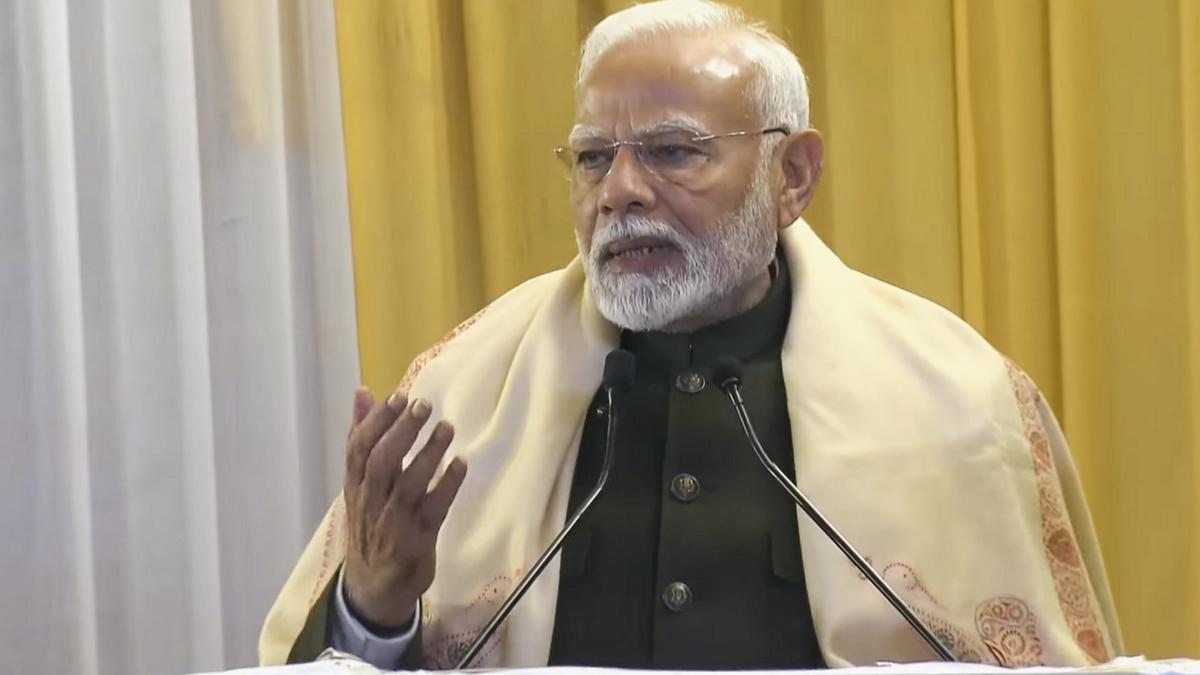In an address in August, Prime Minister Narendra Modi had said that he was hopeful that India’s skilled workforce will play a prominent role in the global job market.
| Photo Credit: PTI
In an address in August, Prime Minister Narendra Modi had said that he was hopeful that India’s skilled workforce will play a prominent role in the global job market.
Global mega trends, such as demographic transitions, globalisation, technological advancements, and climate change, are significantly altering the demand for, and the supply of, international migrant workers. Among the various facets of such changes, the skills of these workers are assuming centrality in public policy discourse.
Reviews of immigration policies of the traditional and major migrant destinations (the U.S., the U.K., Canada, and Gulf Cooperation Council countries) and of the new destinations (Germany, South Korea, Japan, etc.) reveal the increased prioritising of skill-selective and skill-intense immigration. Most of the destination countries recognise that their ability to respond to certain developments, such as an ageing society, digitalisation, declining fertility rates, and the need for economic diversification strategies to tackle the challenging global economic environment, can be met only by welcoming international migrant workers with the relevant skills.
Can India rise to the occasion and bridge the global skills gaps? Responding effectively to the skill needs of different destination countries is a complex task. Robust and evidence-based policy interventions are essential to facilitate skill-centred international labour migration outflows from India.
Fragmented policy structure
However, India still lacks a comprehensive policy architecture for international labour mobility. The policy interventions are fragmented and are often not based on evidence. The only data source for annual migrant labour outflows from India is the data on emigration clearances, which covers only those with an educational attainment below matriculation and low skilled workers migrating to 18 select countries. Such data inadequacy stands as a major obstacle in formulating constructive polices.
India’s efforts have mostly revolved around bilateral agreements on international labour mobility with different countries covering aspects such as social security, skills, protection, and welfare. These are primarily one-off exercises, not situated within a composite policy framework. Further, there are hardly any evaluations available on the outcomes of these pacts and the learnings from them.
India must design and operationalise a comprehensive national policy on international labour migration, with skill-centred migration anchored as one of the fundamental pillars. Such a policy should clearly set the road map for the different processes involved in transitioning India as the global skill capital.
The way forward
The critical step in this direction is to identify and anticipate the ever-changing skills in demand in select destination countries and the emergent skill gaps across their key sectors and occupations. Organisations such as the European Centre for the Development of Vocational Training are actively involved in skill forecasting for European countries using rigorous methodologies. Data and insights obtained from regional and national skill-forecasting exercises, especially for the U.S., the U.K. and Canada, that mostly cover the medium term (2-5 years), can help India respond to skill needs. This should be supplemented by big data analytics of real-time online job vacancies in destination countries for which India seeks to become the lead supplier of skills.
Once this is done, India’s capacity to provide the requisite skills must be assessed. This will entail systematic mapping of the country’s skill development efforts related to skill mobility and follow-up actions: introducing identified skills and competencies as a part of the curriculum in specific institutions; reorienting skill programmes of India’s International Skill Centres to meet the global skill gaps; creating customised short-term skill training geared towards destination countries; and so on. The priority must be to raise the quality of skill development to international standards. This calls for the convergence of the skill qualification systems of India and the destination countries. India also needs a review of the National Skills Qualification Framework to assess its effectiveness in aligning our qualifications with those of the major destination countries.
Considering that contemporary immigration policies encourage temporisation, return migration is gaining prominence in international skilled migration flows. This is another area where India falls short: the optimum utilisation of return migrants’ skills is one of the most neglected aspects of the country’s migration policies. The best way to effectively reintegrate return migrants is to ensure that the skills and competencies they acquire in the destination countries are accredited by specialised skill certification institutions in those countries so that migrants can transition back effectively to the Indian labour market when they return.
Another pressing need is a skill-centred international labour migration information system, encompassing quantitative and qualitative indicators. Such a platform should regularly collate, generate, analyse, and report information and data on key indicators of skills and migration to enable evidence-based interventions. This will be pivotal in fostering skill partnerships between India and the principal destination countries, boosting skill-centred mobility, and improving migration and developmental outcomes.
Published – December 24, 2024 12:15 am IST

